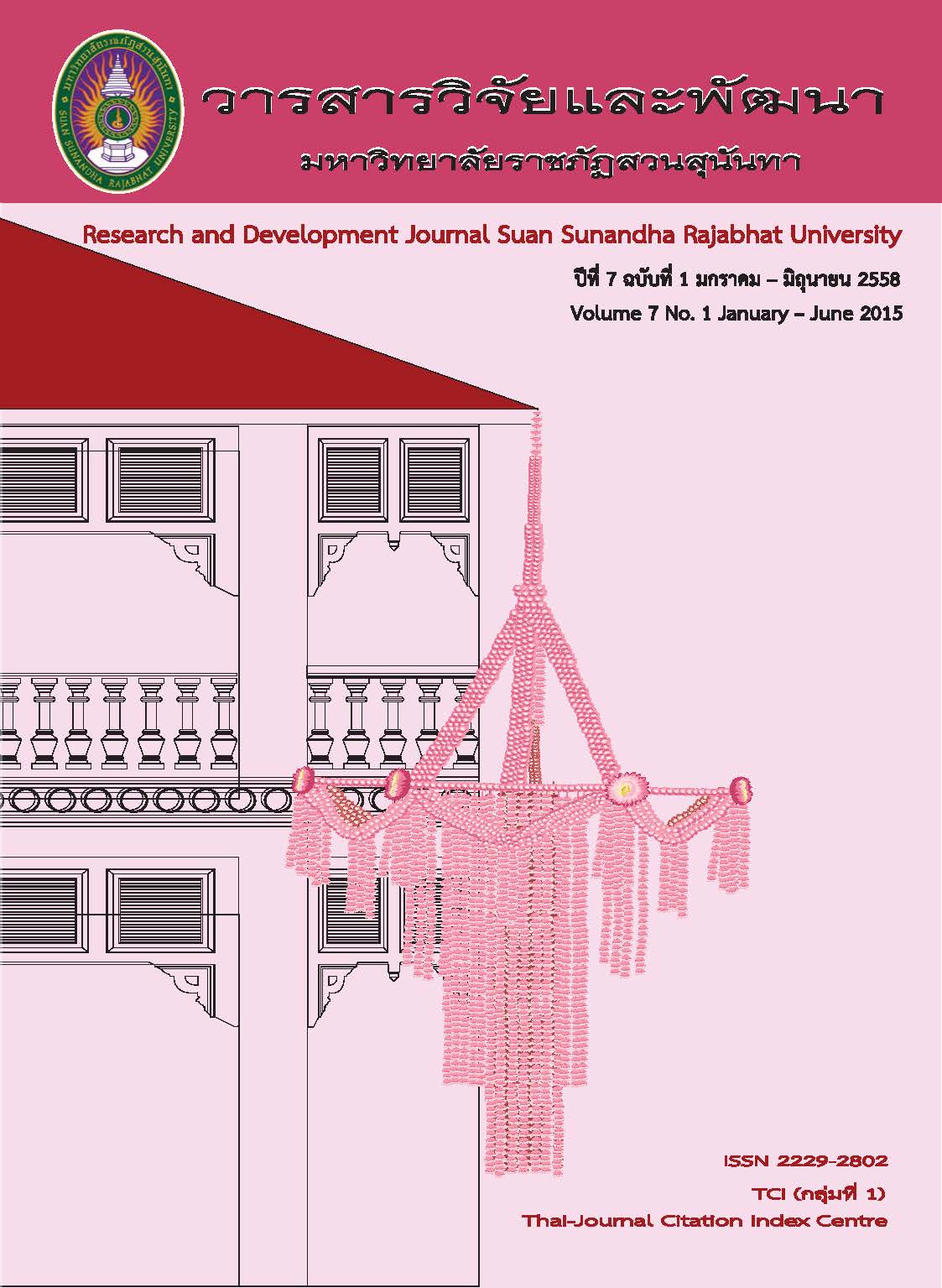การศึกษาภูมิปัญญาการย้อมสีย้อมธรรมชาติจากต้นฝาดดอกแดงสำหรับการพัฒนาผลิตภัณฑ์ชุมชนในตำบลบ่อ อำเภอขลุง จังหวัดจันทบุรีเพื่อส่งเสริมวิสาหกิจชุมชน
DOI:
https://doi.org/10.53848/irdssru.v7i1.214569คำสำคัญ:
การย้อมสี, สีธรรมชาติ, ฝาดดอกแดงบทคัดย่อ
งานวิจัยนี้เป็นการวิจัยเชิงทดลองและเชิงปฏิบัติการแบบส่วนร่วม โดยมีวัตถุประสงค์เพื่อศึกษากรรมวิธีการย้อมสีจากต้นฝาดดอกแดง ซึ่งมีกรรมวิธีการดังนี้คือ 1) ขั้นตอนการสกัดสีด้วยวิธีการต้มเปลือกต้นฝาดดอกแดงโดยมีอัตราส่วน เปลือกต้นฝาดดอกแดง 1 ก.ก. ต่อน้ำ 1 ลิตร 2) ขั้นตอนการย้อมสีแบ่งเป็น การย้อมร้อนและการย้อมเย็น โดยมีการใช้สารช่วยติดสี 4 ชนิดคือ เกลือแกง น้ำด่างขี้เถ้า น้ำมะขามเปียก และสารส้มโดยมีอัตราส่วนระหว่าง น้ำสี 1 ก.ก. ต่อ เกลือแกง 30 กรัม สารส้ม 30 กรัม น้ำมะขามเปียก 100 กรัม และน้ำด่างขี้เถ้า 500 กรัม ตามลำดับ ซึ่งสามารถสรุปผลการย้อมได้ว่า สารช่วยติดสีที่ช่วยติดสีได้ดี เกลือแกงและน้ำด่างขี้เถ้า ส่วนสารส้มและน้ำมะขามเปียกช่วยให้ติดสีเพียงเล็กน้อย วิธีการย้อมที่ดีที่สุดคือกรรมวิธีการย้อมร้อนและย้อมเย็นโดยผสมเกลือแกงระหว่างย้อม การย้อมร้อนระยะเวลา 1 ช.ม.และย้อมเย็นมีระยะเวลาแช่ผ้าทิ้งไว้ในน้ำสี 1 ช.ม. 6 ช.ม. และ 1 วัน เมื่อย้อมเสร็จนำมาแช่ทิ้งไว้ในน้ำด่างขี้เถ้าทิ้งระยะเวลา 1 ช.ม. 6 ช.ม. และ 1 วัน และนำไปตากแห้งและนำไปซักด้วยน้ำเปล่าผ้ามีการติดสีได้ดี โดยเมื่อทิ้งระยะเวลาที่แช่ผ้าในน้ำด่างยิ่งนานสียิ่งเข้มขึ้นแต่ผ้าที่ผ่านกรรมวิธีย้อมร้อนนั้นสีเข้มน้อยกว่าผ้าที่ผ่านกรรมวิธีย้อมเย็นเมื่อเทียบในระยะเวลาเดียวกัน ข้อเสนอแนะจากการวิจัยครั้งนี้คือควรจะทดสอบความคงทนของสีหลังการย้อม โดยทดสอบในห้องปฏิบัติการทางวิทยาศาสตร์
เอกสารอ้างอิง
โครงการฝ้ายแกมไหม. (2546). คู่มือการย้อมสีธรรมชาติฉบับผู้รู้ท้องถิ่น. ม.ป.ท.
นิรชา ศรัทธาทิพย์กุล และนิศารัตน์ อริยะเครือ. (2552). กรุงเทพฯ : สำนักวิจัยและพัฒนาหม่อนไหมเฉลิมพระเกียรติ
พรเพ็ญ โชชัย และเมทินี ทวีผล. (2556). การย้อมสีเส้นด้ายฝ้ายด้วยสีย้อมธรรมชาติจากใบและเปลือกต้นมะม่วงสำหรับอุตสาหกรรมครอบครัว. วิจัยเพื่อการพัฒนาเชิงพื้นที่,5(4),116-129
พรสันต์ เลิศวิทยาวิวัฒน์ ( ม.ป.ป ). ลักษณะสำคัญของการวิจัยเชิงปฏิบัติการแบบมีส่วนร่วม. เข้าถึงเมื่อ 9 ตุลาคม 2555. เข้าถึงได้จาก www.lamptech .ac.th/webprg/article_top/file_ar/a208984PAR.doc
วรรณี ทัฬหกิจ. (2553). ฝาดดอกแดง. เข้าถึงเมื่อ 9 ตุลาคม 2557.เข้าถึงได้จาก http://tanhakit
blogspot.com/2010/12/blog-post_3764.html.
ศรันยา เกษมบุญญากร. (2557). สีธรรมชาติ: ความเคลื่อนไหวของสิ่งทอเชิงอนุรักษ์. ภาควิชา คหกรรมศาสตร์ คณะเกษตร มหาวิทยาลัยเกษตรศาสตร์.เข้าถึงเมื่อ 9 ตุลาคม 2557. เข้าถึงได้จาก http://
www.pirun.ku.ac.th/~agrsyp/?page_id=86
ดาวน์โหลด
เผยแพร่แล้ว
รูปแบบการอ้างอิง
ฉบับ
ประเภทบทความ
สัญญาอนุญาต
บทความที่ได้รับการตีพิมพ์เป็นลิขสิทธิ์ของ สถาบันวิจัยและพัฒนา มหาวิทยาลัยราชภัฎสวนสุนันทา
ข้อความที่ปรากฏในบทความแต่ละเรื่องในวารสารวิชาการเล่มนี้เป็นความคิดเห็นส่วนตัวของผู้เขียนแต่ละท่านไม่เกี่ยวข้องกับมหาวิทยาลัยราชภัฎสวนสุนันทา และคณาจารย์ท่านอื่นๆในมหาวิทยาลัยฯ แต่อย่างใด ความรับผิดชอบองค์ประกอบทั้งหมดของบทความแต่ละเรื่องเป็นของผู้เขียนแต่ละท่าน หากมีความผิดพลาดใดๆ ผู้เขียนแต่ละท่านจะรับผิดชอบบทความของตนเองแต่ผู้เดียว





